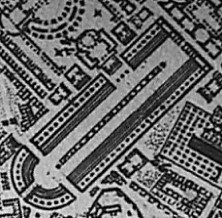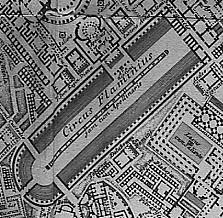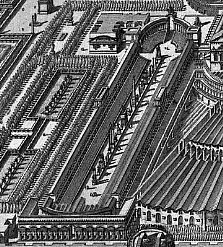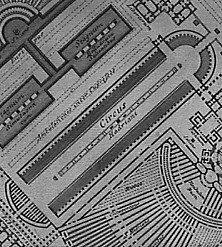back to the Campo Marzio
2001.09.08 16:50
Hello John,
...getting back to the two states of the Ichnographia, here are some further thoughts and questions:
1. I believe the first state is the plan as it is NOT published in books today. If you look at the smaller and earlier plans of the Campo Marzio within the plates prior to the Ichnographia, you will see earlier plans of the Circus Flaminius the same as the Circus Flaminus plan within the first state Ichnographia. Furthermore, the aerial view the Circus Hadriani within the frontispiece corresponds in plan with the first state Ichnographia.
 
 
2. I think the circus delineations of the second state (which are all virtually identical to each other) are in fact delineations based on the Circus of Maxentius (rather than the Circus Maximus). This is somewhat significant in that (according to my research and interpretation of the Ichnographia as a double narrative relating Rome's inversion from pagan city to Christian city) Maxentius is exactly the ruler of Rome immediately prior to Constantine's Chistian efforts.
3. ...now knowledgable of the practice of damnatio memoriae, I wonder if Piranesi purposefully 'erased' portions of the Ichnographia as a reenactment of the damnatio memoriae practice, and, like some extant examples of dm inscriptions, if he then purposefully followed up with a palimpsest (of another plan) over the erasure.
4. I realized that I have yet to see an actual print version of the second state of the Ichnographia. All I've ever seen is an actual first state (1761) version. Do you know if you've seen an actual eighteenth cent. print version of the second state? Moreover, did you happen to make a trip to Rome to see which state the actual engraved plates are in? It is the current state of the plates that would surely identify the second state (that is, unless someone long ago altered a reproduction, and it happens to be an altered reproduction that's been printed in books all these years).
5. I also believe that it was indeed Piranesi that made the changes. My main reasoning here is that Piranesi was very likely the only person that could have made the changes with such dexterity.
As to Tafuri, I have documented so many cases within the Ichnographia that carried explicit meaning and message on Piranesi's part, that all of Tafuri's theorizing that the Ichnographia is indicative of and/or percursor to the modern meaninglessness of architectural form is plainly and emphatically wrong. What Tafuri obviouly never did, but definitely should have done, is to translate all the Latin labels that Piranesi applies to virtually all the plans of the Ichnographia. It is only through reading the labels and the planimetrics in combination that the full meaning of Piranesi's Campo Marzio comes through.
All the best,
Steve Lauf
| |
The arrogance of 'Architects'
2008.08.08 13:27
In the Ichnographia Campo Martius "certain landmarks remained: the Tiber River, the Piazza Navona, and a Colosseum-like structure, which was in the wrong location and, in a sense, at the wrong
scale."
--Peter Eisenman, "Piranesi and the City" (2007).
In fact, the 'Colosseum-like structure' is clearly labeled Amphitheatum Statilii Tauri, positioned by Piranesi in its most likely location, and delineated at about 2/3rds the size of 'the Colosseum' which is probably what the Amphitheater of Statilius Taurus was.
Eisenman's misrepresentation of the facts here is somewhat compounded in that Wilton-Ely had already years earlier noted the presence of the Amphitheater of Statilius Taurus within Piranesi's Campo Marzio.
Eisenman inerpretes Piranesi's Ichnographia Campus Martius in several self-serving ways, but he never comes to realize that on one level the Ichnographia Campus Martius is a gigantic test of Ancient Roman topography.

"Hey Doctor. I don't know what you want me to see, but this thing I'm looking through looks like some plan from Piranesi's Campo Marzio.
Adam (sans Eve) in the Garden of Satire
2008.08.10 11:29
Piranesi's close familiarity with [Hadrian's] Villa dates back at least to the 1750s, when there are accounts of sketching expeditions made in the company of Robert Adam, Clérisseau and Allan Ramsay.*
--John Wilton-Ely, The Mind and Art of Giovanni Battista Piranesi (London: Thames and Hudson, 1978), p. 41
*See John Fleming, Robert Adam and his Circle in Edinburgh and Rome, London and New York, 1962, passim.
passim : here and there: used in bibliographic references to indicate that the writer has drawn upon material scattered throughout the source cited.
In fact, there is no direct evidence within Robert Adam and his Circle in Edinburgh and Rome that Piranesi and Adams were ever together at Hadrian's Villa, nor does Adam every mention Piranesi having been to Hadrian's Villa. Was perhaps Adam at Hadrian's Villa before Piranesi ever was? It is on record that Adam was at the Villa d'Este mid-June 1755. And again Adam led a survey and drawing expedition at Hadrian's Villa for six days in April 1756.
Many of the specifics we have today regarding Piranesi's life from June 1755 to late-April 1757 come from the coeval letters of Robert Adam. According to Wilton-Ely: The new decade of the 1760s saw a broadinging of Piranesi's antiquarian concerns... A particular field of operation in this decade was Tivoli and the ruins of the nearby Hadrian's Villa.
Here and there indeed.
|